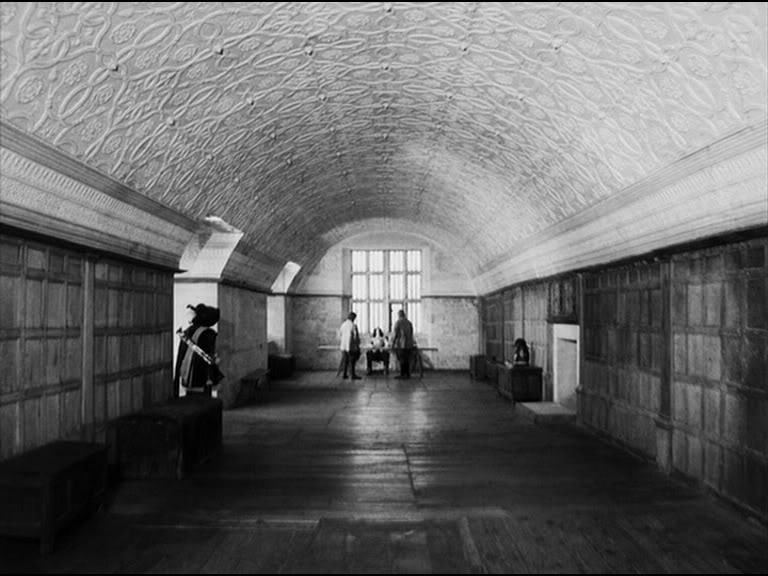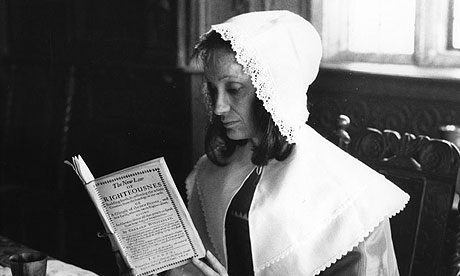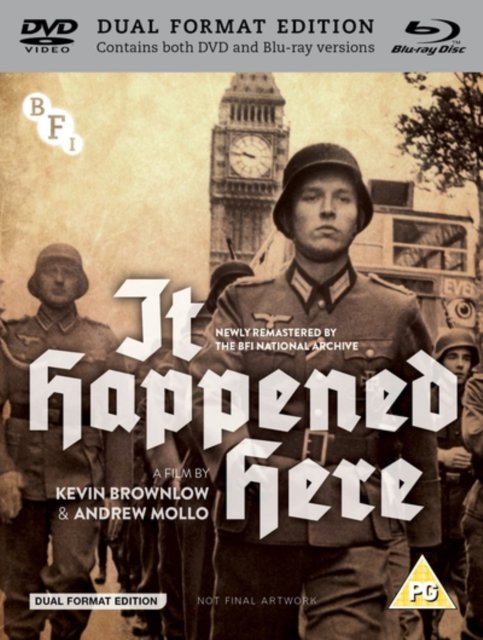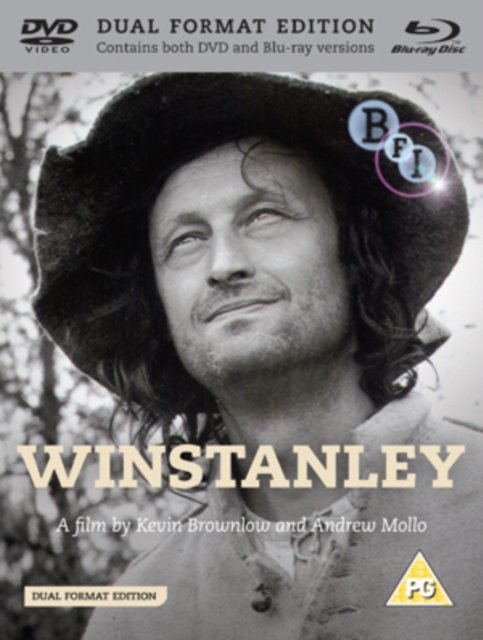From the Chicago Reader (April 13, 1999):
It Happened Here
Rating *** A must see
Directed by Kevin Brownlow and Andrew Mollo
Written by Brownlow and Mollo
With Pauline Murray, Sebastian Shaw, Honor Fehrson, Rex Collett, Nicholas Moore, and Colin Jordan
Winstanley
Rating *** A must see
Directed by Kevin Brownlow
Written by Brownlow and Andrew Mollo
With Miles Halliwell, Alison Halliwell, David Bramley, Dawson France, Phil Dunn, and Terry Higgins.
By Jonathan Rosenbaum
The Music Box will be showing the only two features by English film historian Kevin Brownlow Tuesday through Thursday, April 27 through 29. Both are low-budget independent efforts in black and white, and both have been virtually lost to history because they fall outside what’s usually regarded as the history of English cinema, though their modesty makes them English to the core.
Brownlow is best known for his excellent English TV series, codirected by David Gill, about silent cinema (including Hollywood, Unknown Chaplin, Buster Keaton: A Hard Act to Follow, Harold Lloyd: The Third Genius, D.W. Griffith: Father of Film, and Cinema Europe) and for his books (including The Parade’s Gone By… and Behind the Mask of Innocence). He’ll never be remembered as a major filmmaker, because his methods of historical reconstruction are too fanatical to allow for the sort of dramatic shaping demanded of major period films. But his two movies can’t be dismissed. Their sheer eccentricity demands some attention; they’re roads not taken by others.
Properly speaking, the first of these efforts, It Happened Here (1966)—an intricate imagining of England in 1944 if it had lost the war in 1940 and been occupied by the Germans—qualifies as science fiction. And the second, Winstanley (1975)—an account of the failed effort of a nonviolent religious sect called the Diggers to establish a commune in Surrey in 1649—qualifies as a period piece. But to my mind both films are science fiction, because a vanished era is the focus of the sort of curiosity, awe, and wonder commonly reserved for the future. In part because of the fanaticism about period details, both works are theoretically and stylistically somewhat naive movies, endowing the past with a voluptuous sense of mystery rarely found in more accomplished pictures.
This was certainly my reaction when I first saw Winstanley in London a year after it was completed. At that point it still didn’t have an English distributor and had turned up for only a limited run shortly after the release of Stanley Kubrick’s Barry Lyndon. It was difficult not to see the films as doing similar things: both directors had previously made SF films—in Kubrick’s case, Dr. Strangelove, 2001: A Space Odyssey, and A Clockwork Orange–before delving into the remote past. Though we tend to regard the past as known and the future as unknown, Brownlow and Kubrick understood that the past is just about as unknowable as the future—and just as worthy of wonder. (Incidentally, Kubrick furnished Brownlow with some of his leftover 35-millimeter film stock from Dr. Strangelove to shoot It Happened Here; another commercial director, Tony Richardson, later helped pay for its completion.)
I hasten to add that Brownlow is an antiquarian with none of Kubrick’s prophetic vision, craft, or talent. When a respected art and film critic who was one of Kubrick’s biggest champions complained to me in the 70s that Winstanley seemed the work of a very old man, I replied that this was precisely what I liked about it. I still more or less feel that way. For her, 2001 powerfully imparted a sense of weightlessness, where Winstanley was weighted down by gravity in every sense of the word. I still can’t refute that charge, but the sheer intransigence of Brownlow’s two features makes them uncommon acts of devotion toward the past.
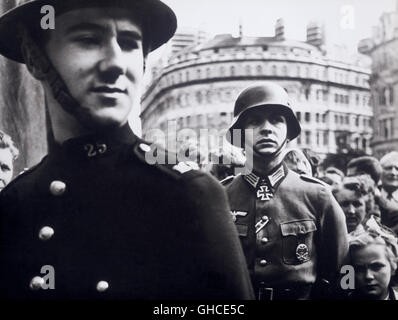
I only recently caught up with It Happened Here, which is showing in the U.S. in its original form for the first time. Back in 1965 United Artists excised seven minutes of it under pressure from Jewish groups that objected to a sequence in which Colin Jordan—at that time head of the British National Socialist movement and playing a leader in the fictional Immediate Action Organization in the film—spontaneously aired his opinions about Jews and euthanasia. Fearing his words might be taken seriously by members of the audience who didn’t pick up on of the film’s anti-Nazi position, the groups argued that the sequence was too dangerous.

It’s typical of Brownlow’s method that only a real fascist would be called upon to express fascist positions; by the same token, patients suffering from tuberculosis in the film were played by real TB patients in a real TB rehabilitation center (actually the former house of Sir William Gilbert of Gilbert and Sullivan). In any case, it took Brownlow more than 30 years to regain the rights to the film so that he could restore the sequence —which is in some respects the most interesting one in the film. If some of the gestures toward authenticity in this film and Winstanley register as naive—if only because the fruits of exhaustive research are at times more apparent to the filmmakers than they possibly could be to spectators—here the gesture clearly pays off, lending a documentary-like authenticity to any speculation about what an English Nazi in 1944 would have sounded like. Even Jordan’s faltering speech patterns lend credence to the portrait.
Brownlow started work on It Happened Here in 1956, at the age of 18, finished it eight years later, then had to wait two more years for United Artists to release it. (From inception to release, Winstanley took nearly as long.) He enlisted military historian Andrew Mollo to help with the 40s costumes and eventually invited him to collaborate on the script and direction, and Mollo persuaded him to discard the footage he’d shot and start over again. Most of the actors in both pictures are nonprofessionals, and though the status of both movies as “amateur” productions often works in their favor, the superiority of the one professional in It Happened Here (Sebastian Shaw, playing Dr. Richard Fletcher) to everyone else in the cast is hard to miss.
It Happened Here launched the filmmaking careers of two notable collaborators. Production assistant Peter Watkins subsequently made many meticulous and powerful pseudodocumentaries, including The War Game and The Battle of Culloden, and his methods show him clearly indebted to Brownlow and Mollo. Cinematographer Peter Suschitzky went on to shoot Leo the Last, The Rocky Horror Picture Show, The Empire Strikes Back, Mars Attacks!, and all the films of David Cronenberg since Dead Ringers, including eXistenZ; the focused dramatic intensity associated with these later movies is found only sporadically in It Happened Here and Winstanley, which are relatively studied and distanced by comparison.
Suschitzky’s work on It Happened Here is pretty stunning throughout, yet one often feels that Brownlow and Mollo are more interested in creating and contemplating a particular world than in telling a particular tale. (Significantly, the story doesn’t end with a clear climax or resolution; it simply stops.) To some extent, this argues in its favor: we’re offered an encapsulation of what English fascism in the mid-40s might have looked, sounded, and felt like—and trusted enough as spectators to find our own ways through this material rather than being taken along a carefully programmed conveyor belt. The central character is a district nurse (Pauline Murray) in Salisbury who travels to a demilitarized London after resistance activity drives the Germans to evacuate citizens, and she winds up being trained to work for the fascist-controlled Immediate Action Organization. She’s an apolitical figure repulsed by the violence of partisans and fascists alike, but circumstances eventually force her to recognize that these two forms of violence hardly amount to the same thing. The film is much more interested in the everyday details of what she encounters than in constructing a consciousness-raising polemic. The same impulse is even more apparent in Winstanley, which is passionate about historical detail but relatively unconcerned about making a connection between communal aspirations in 1649 and those during the height of the counterculture in the 1970s—a connection that more commercial filmmakers would have sought rather than avoided. The motive behind this avoidance is clearly an interest in making the film more amenable to multiple interpretations of what Gerrard Winstanley’s commune meant and continues to mean, but viewers looking for easy equations of past and present are likely to feel somewhat cheated.
The movie challenges us to become as fascinated and obsessed with the mysteries of the past as the filmmakers are. They even went so far as to scour England and consult animal-husbandry experts to find birds, cows, and pigs that were most likely to resemble those of the 17th century and to transfer a barn from Essex piece by piece; in It Happened Here they contrived to find mainly original rather than merely authentic costumes and props (buses as well as artillery) and refrained from using any archival footage, even when they needed newsreel material from World War I. Most viewers might interpret this as a form of perversity or madness, but they could also regard it as a form of uncommon respect.
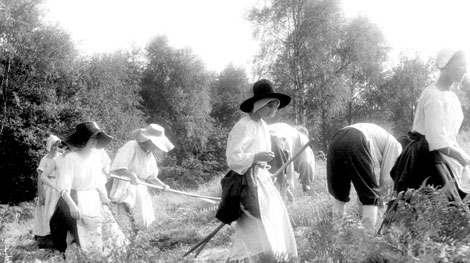
The textures of Ernest Vincze’s cinematography in Winstanley are even more studied than those of Suschitzky’s work—again, documentation mainly triumphs over narrative. Winstanley was inspired by David Caute’s novel Comrade Jacob—a book brought to Brownlow’s attention by Miles Halliwell, who played an Immediate Action Organization political lecturer in It Happened Here and wound up being cast as Winstanley—but the independent research of Brownlow and Mollo reportedly drove them away from their source as they proceeded. The film is at pains to teach us a detailed lesson about a neglected chapter in English history, yet at times one feels that the deeper Brownlow and Mollo dug the more questions they had. Still, films that raise questions rather than provide answers usually haunt us more than films that satisfy standard Saturday-night urges. (It’s worth adding that Marxist film theorists in England at the time–the most influential of whom congregated around the journal Screen–didn’t welcome Brownlow and Mollo’s efforts, regarding them as naive and “undertheorized.”)
The framing, lighting, and editing of both films show how much Brownlow absorbed from silent cinema, though this influence is much more pronounced in Winstanley, which opens with a prologue in which Prokofiev’s Alexander Nevsky score accompanies a battle scene straight out of silent Russian cinema (or Orson Welles’s Chimes at Midnight), punctuated by explanatory intertitles (“1646: The King Against Parliament” reads the first). The avowed visual sources of the remainder of the film are two silent pictures, Arthur von Gerlach’s The Chronicles of the Grey House and Carl Dreyer’s The Parson’s Widow. On the whole Winstanley is even more ambitious than It Happened Here—less dramatically engaging but more mysterious as it contemplates the great bottomless density of the past.
Insofar as Winstanley‘s presocialist “experiment” was an abysmal failure, it has an enduring sense of pathos that reflects the filmmakers’ effort to do the impossible. There’s also a remarkable sense of immediacy in the handheld camera work of both Brownlow’s pictures that reveals how shopworn and streamlined the supposedly innovative Normandy-landing sequence of Saving Private Ryan actually is. Indeed, if nothing else, It Happened Here and Winstanley offer lessons on how stupefyingly insulting the period re-creations of most commercial movies are; much as It Happened Here diminishes Spielberg, Winstanley makes the period plushness of Shakespeare in Love and of Merchant-Ivory look like window dressing. And as SF movies with an enduring sense of wonder about the world, despite a conspicuous lack of special effects and production values, they surpass virtual-reality games like The Matrix and eXistenZ, which for all their provocative and eye-filling virtues can’t hold us much longer than their running times. Even if you don’t enjoy these black-and-white movies every moment that you’re watching them, my guess is you won’t forget them. They seep into your consciousness like the photos in the most intimate of family albums, redefining who you are in the process.

